Tying the Knot: Kikuyu

Mizuhiki is the name for tightly twisted cords made of Japanese paper which are tied into elegant and complex knots and used to decorate money envelopes and traditional wedding engagement gifts. The traditional red and white cords express a life-affirming and celebratory message. The complex knots, while decorative, also symbolize the ties binding people together. We’ve visited Kikuyu, a shop which was founded in 1888, and talked to the president, Mr.Yoshinobu Watanabe about his experiences and challenges trying to bring this traditional art to a wider audience while preserving the deeper message.
Interviewed by Reiko Yamamoto. Translated by Claire Tanaka
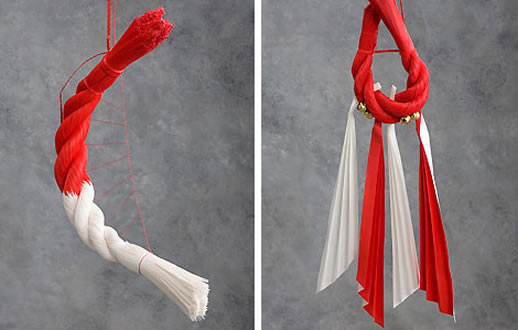
Q: I understand that Iida has a four hundred year history of making mizuhiki?
A: Iida City is sandwiched between the Southern Alps and the Central Alps and so it’s a place with plenty of water and kozo, the mulberry plant, which is used for making Japanese paper. They say this region was originally a paper producing area. In the late 1600s, an artisan named Bunshichi Sakurai developed a strong, bright, high-quality type of motoyui (a paper cord used to bind the hair into a topknot), and Iida Motoyui became known nationwide. After that, with the movement to westernize the nation during the Meiji period, men were ordered by law to cut their hair short with the Danpatsu Edict of 1871. As a result, the market for motoyui shrunk, but the culture of mizuhiki came to take its place and became a popular item in people’s daily lives. Now, seventy percent of all the mizuhiki in Japan is made in Iida. It’s a big industry in this city.
Q: There are so many different ways to tie the cords. Approximately how many variations are there?
A: There are lucky symbols like the pine, bamboo, plum, and tortoise, and there are about twenty different kinds of flat knots that have been passed down since old times, so by combining those elements you can make a lot of different designs. Mizuhiki was originally used to bind money envelopes and traditional wedding engagement gifts and the designs were all flat, but more and more flamboyant designs became popular over time and the art expanded to include three dimensional works.
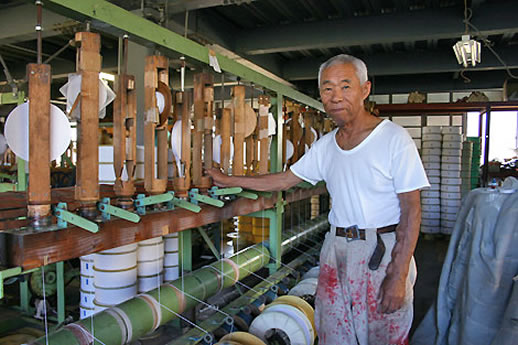
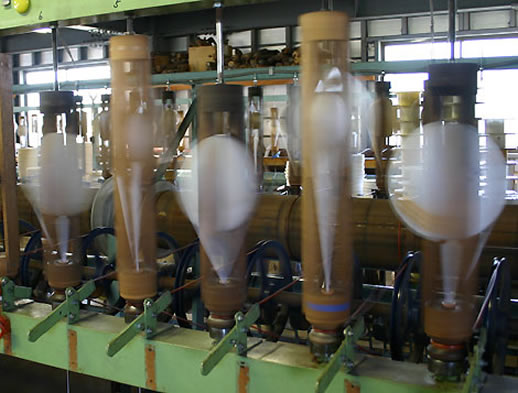
Q: Speaking of developing new designs, I understand you’ve been participating in the JAPAN BRAND project since 2004. What kind of work have you done with the project?
A: We participated in exhibitions in Los Angeles and Paris, and we’ve mostly been working on promoting the traditional Japanese art of mizuhiki overseas. We felt that if we only did the project for one year then it wouldn’t be very effective, so we’ve been voluntarily participating every year and trying new things along the way.
Q: What kind of reaction did you get overseas?
A: In Los Angeles (2004) we participated in a large gift show. A lot of people came and we did live demonstrations in a magic show-like style. We had a great reaction from the locals, but it didn’t result in any concrete business relationships in the end, and I really saw how difficult it can be to distribute a product in a large country such as the United States. In Paris (2006) we had a much more critical response than I expected. We had brought traditional Japanese motifs such as knots and helmets to display, but the local organizer said, “Traditional craft is alright, but you won’t get many buyers. You’ve got to make something more arty, more expressive, or you won’t get far.” I realized that we were going to have to shed our old ways of thinking and get away from what we had always done. That was the reason why we got involved in last year’s project.
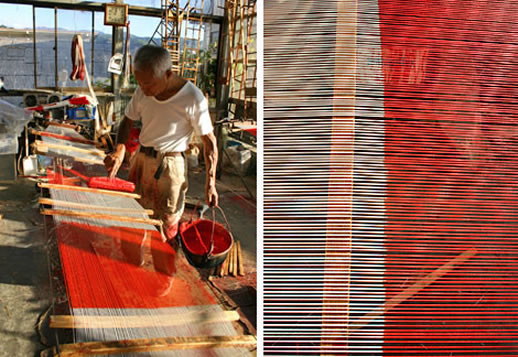
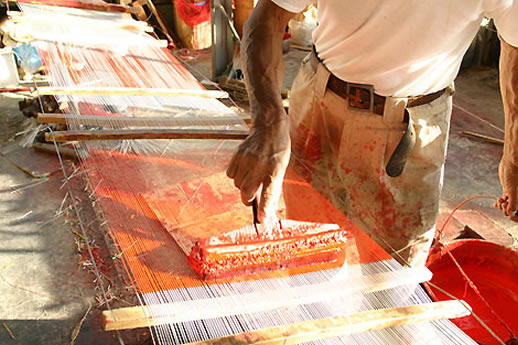
Q: That was your collaboration with designer Masafumi Arita, which was featured in PingMag in 2007, right?
A: Yes. What we were told in Paris about using basic mizuhiki techniques to make art was right on, so we decided to try and use simple and basic knots to make a product that would sell. That was when I met Mr. Arita, and he had an interest in old Japanese arts so we really saw eye-to-eye on things and decided to try developing a series of mizuhiki greeting cards. It was right around then I had been setting my sights overseas but I started to think that it was also important to try and focus on the young generation within Japan and try to express the appeal of the culture of mizuhiki to them. That was around the same time when I started to get involved with designers like Masafumi Arita, and in February of 2008 we held an exhibition and workshop about mizuhiki in Tokyo’s Setagaya ward. A lot of professional designers participated in the workshop, and everyone listened very seriously and worked hard, so that made me happy. Afterwards we spoke to a lot of people who said things like, “I want you to hold another workshop,” and “Next time I want you to focus on this aspect.”
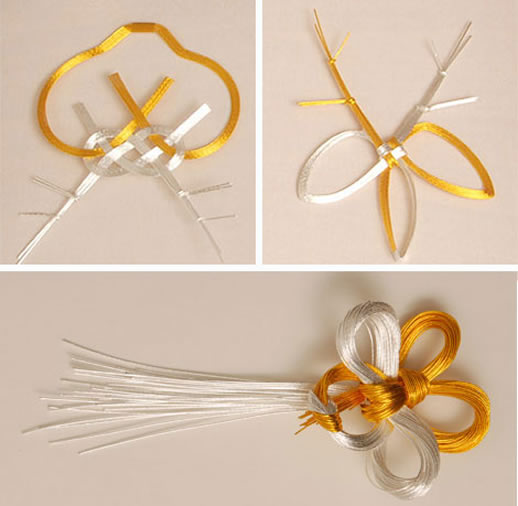
Q: You opened a new path within Japan.
A: When we hold a workshop to teach people how to tie the cords the participants enjoy themselves and we feel good too, make no mistake. However, when we want to expand the business angle but it never gets further than, “I want some of the mizuhiki materials” I think we’ve got to think about whether that’s really what we want from this. I think that what we really want is to be able to sell something we’ve put our hearts into making.
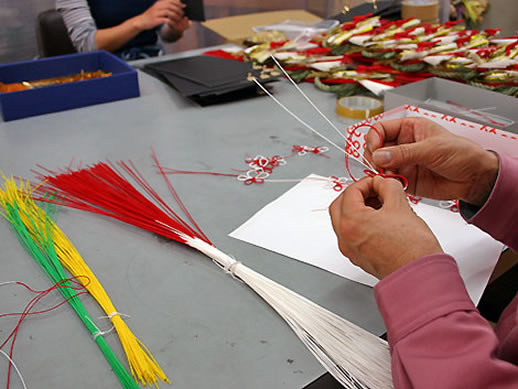
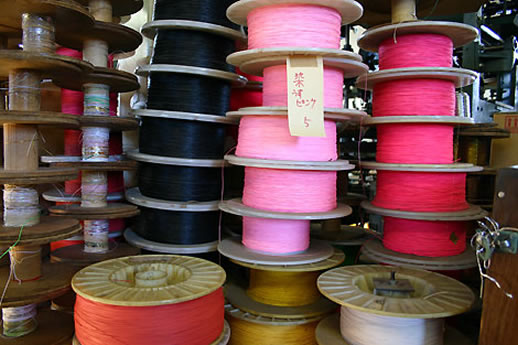
Q: What is the biggest lesson you’ve learned from these past few years of involvement?
A: By participating in the JAPAN BRAND program and having the chance to meet so many people and travel overseas, I realized that our old way of thinking was very narrow, and also I’ve had to reflect on how we hadn’t been thinking about how to preserve the best parts of what we do for the future. Before participating in the project, I’d just been in the habit of thinking how we had to make something new.
Q: You had been feeling a sense of urgency, perhaps?
A: Yes, that could be it. But if you just feel anxious, nothing will come of that. (laughs) On the other hand, we’ve got a solid base, so even if we don’t make something new, how can I put it, we’ve got a steady flow going. For example, we take great care in the quality of our basic white and red mizuhiki cord. My father always said, “The red mizuhiki is the color of our precious, life-giving blood, and the white is the color of mother’s milk that is so important to a newborn baby. That’s why, just like the human body, the red and white mizuhiki is very important.” I always heard him say that. I had always heard it but somewhere along the way I had forgotten. Now I remember it very clearly. Really, the simpler something is, the deeper it goes. I’m thinking that’s where something interesting can start to happen. I told that story to Mr. Arita and I said it can’t just end with “Oh, that’s lovely, that’s wonderful.” It’s not just about the skill needed to make the knots, or the flashy, glitzy element of the product. We’ve got to make sure the story behind mizuhiki also gets told. That’s how I’ve begun to think, lately.
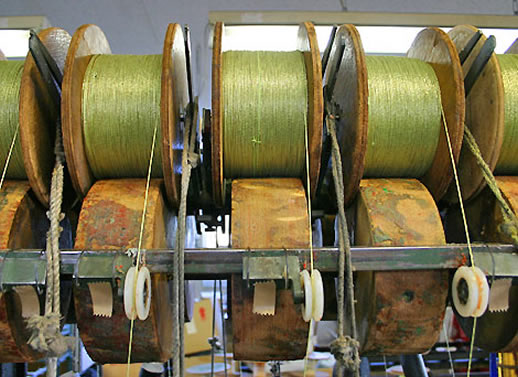
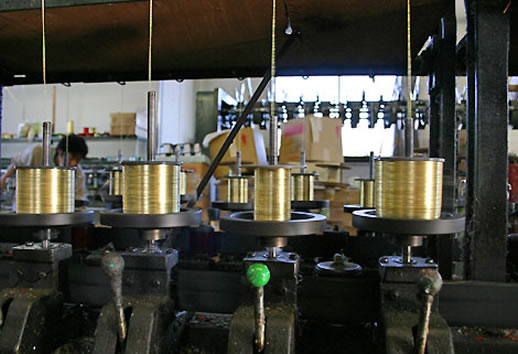
Q: The red certainly is fresh and beautiful. You say you take special care when making these cords. Could you tell me more?
A: Each craftsman produces a slightly different variation of red, but the color is more or less standardized. The red part of the mizuhiki cords are painted by hand. The slightly uneven part where white meets red on the cords is how you can tell it was done by hand. In the old days, people used to cover that part up with tape to hide it, but I like to show it. I think there’s a richer depth of expression when it’s visible. They say people instinctively feel calm and energized when they see red and white. If you put a red object in a room, it brightens the atmosphere, and there aren’t many people who say they dislike the color red. Since it is the most basic part of mizuhiki, we do take special care with the red and white cords.
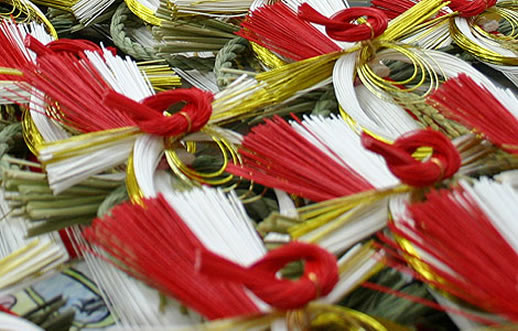
Q: Tell me a bit about your coming plans and challenges.
A: We’ve already had exhibitions overseas, workshops domestically, and collaborated with a designer. Next, our challenge is how to “tie it up” with some related business, and how to carry this important Japanese cultural tradition on for the next generation. Rather than try to make a new custom, I think it’s important to help people find an opportunity to use mizuhiki more in their everyday lives. Now, people have the image that mizuhiki = special occasion, and it has been distanced from most people’ everyday life, but I’m thinking it would be great if the use of mizuhiki during annual holidays such as New Years became part of people’s normal routine. Every time I do something new, I get new worries. (laughs) If I didn’t try anything new I suppose I wouldn’t have any worries, but I wouldn’t be able to make anything new either.
Kikuyu Miyanomae 4480, Iida City, Nagano
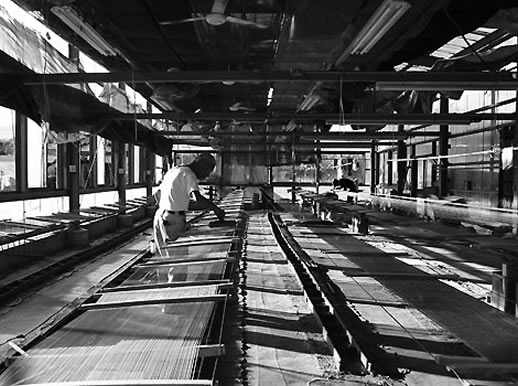

A Word from a Regional Project Participant


The Iida Chamber of Commerce and Industry has been participating in a JAPAN BRAND program called Iida Musubi since 2004. Now in our fourth year, 2008, we are no longer receiving financial support from the government but are continuing the program with our own funds. We’ve participated in exhibitions overseas in places such as Los Angeles and Paris, and held a variety of workshops and exhibitions within Japan, working hard to tell as many people as possible about the tradition and culture of mizuhiki. In our first year, about twenty mizuhiki companies in Iida participated in the program. Originally, we were supposed to finish the program in just one year and we were expected to produce results. We were so busy making prototypes and going overseas that it was hard to find the time to relax and really reflect on things. We had a lot of trouble trying to decide how to present and explain our product when preparing for our overseas debut; we were lost at whether to make Japanese-style mizuhiki or try to create a Western-style product. But we were finally able to grasp it once we went and saw for ourselves how mizuhiki is perceived overseas. That was when we got serious about expanding overseas, and five companies which were particularly engaged in the project came together and decided to continue the program. Kikuyu’s President Yoshinobu Watanabe is one person who thinks of his business not just as a small family business but as one part of Iida’s mizuhiki industry. He is thinking about our future and struggling to promote the mizuhiki tradition. When we participated in an exhibition in Paris, a French designer told us, “Mizuhiki is lovely, but you need to have to put more effort into getting the message out about your product.” That gave us a lot to think about and provided us with direction. However, even though we knew how important it was to promote ourselves right, we just couldn’t seem to find a way to do it. I think it was really lucky that we were able to meet a designer with an interest in traditional arts like Masafumi Arita at that time. What’s coming next? We’re going to continue collaborating with designers like Mr. Arita and developing our business.
Japan Brand
Japan Brand



